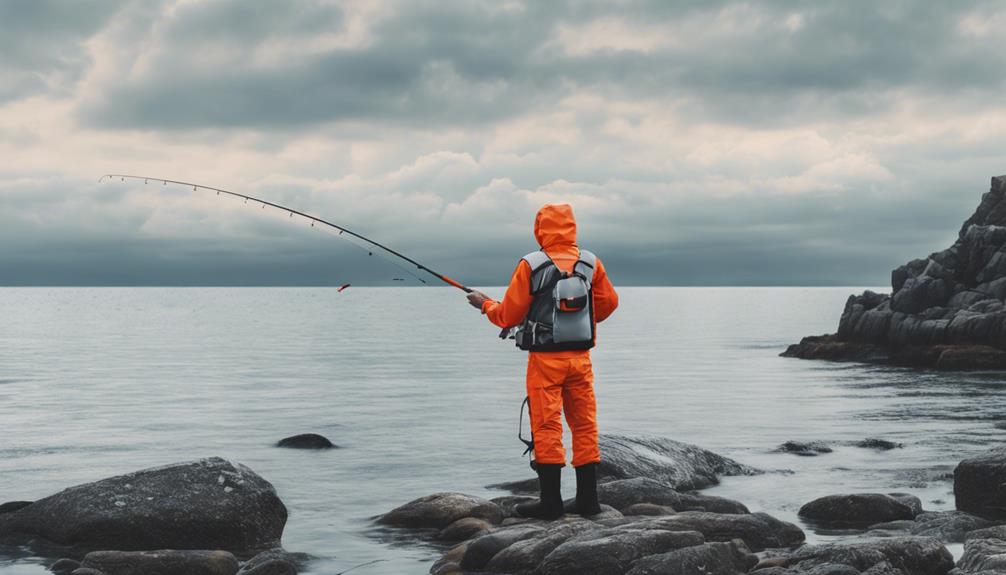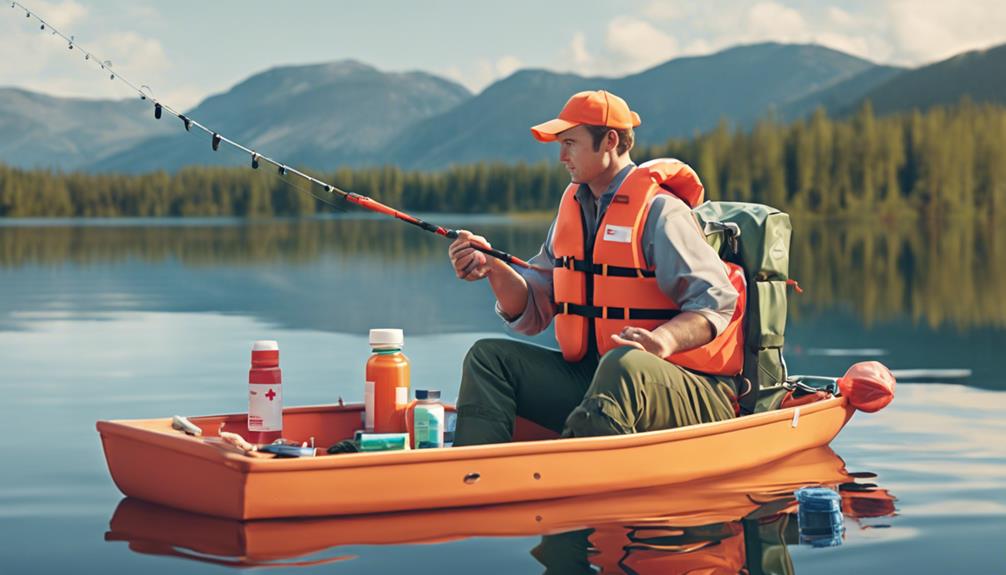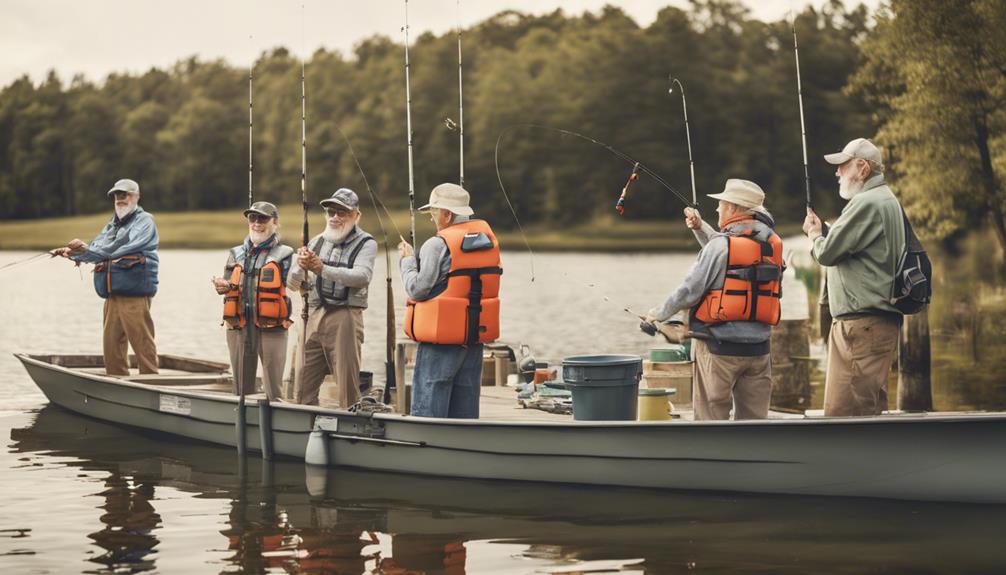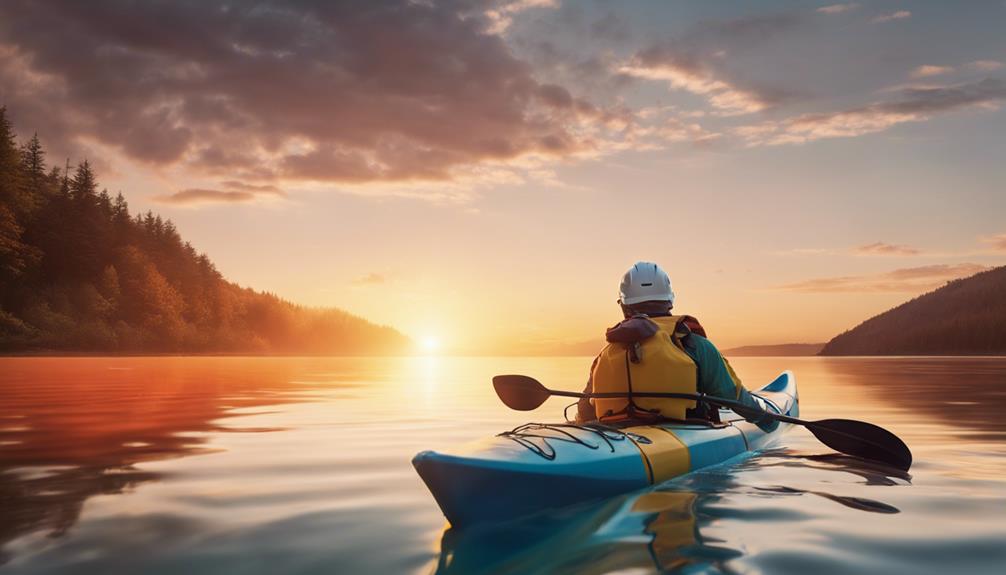Imagine yourself as a fisherman casting your line into the vast unknown, much like navigating the waters of safety while shore fishing.
With 7 essential practices, you can ensure a secure and enjoyable experience. From understanding local regulations to preparing for emergencies, each tip will equip you with the knowledge needed to safeguard yourself and others.
So, grab your gear and let's dive into the world of shore fishing safety, where every precaution taken can make a significant difference.
Importance of Shore Fishing Safety
Understanding the importance of shore fishing safety is crucial for enjoying a safe and rewarding fishing experience. When you venture out to fish from the shore, being aware of water hazards and following safety tips is paramount. Always pay attention to the water conditions, tides, and currents to avoid being caught off guard. Familiarize yourself with the area and know the potential risks such as slippery rocks, sudden drop-offs, or strong undertows. It's essential to wear appropriate footwear with good traction to prevent slips and falls on wet surfaces.
In addition to water hazards, being prepared for wildlife encounters is also vital. Before heading out, educate yourself on the local wildlife that may be present in the area. Take precautions against encounters with animals like snakes, insects, or even larger wildlife such as bears or cougars in certain regions. Make noise while walking to alert animals of your presence and avoid surprising them. Carry bear spray or other deterrents if you're in bear country and know how to use them effectively.
Understanding Local Fishing Regulations
Adhering to local fishing regulations is essential for ensuring a responsible and lawful fishing experience. Before casting your line, make sure you're familiar with the rules and guidelines set forth by the local authorities. Ignoring these regulations not only puts you at risk of fines and penalties but also endangers the sustainability of the fish population and the overall ecosystem.
Here are some key points to consider when it comes to understanding local fishing regulations:
- Possess the necessary fishing license: Ensure you have the appropriate fishing license for the area you plan to fish in. Fishing without a license is illegal and can result in hefty fines.
- Respect size limits: Familiarize yourself with the size limits for different fish species. Catching undersized fish can harm the population's reproductive capabilities and overall health.
- Observe catch limits: Pay attention to the maximum number of fish you're allowed to catch per day. Overfishing can deplete fish stocks and disrupt the natural balance of the ecosystem.
- Follow gear restrictions: Some areas may have specific gear restrictions in place to protect certain species or habitats. Adhering to these restrictions is crucial for environmental conservation.
- Stay informed: Regulations can change, so stay updated on any new rules or amendments to avoid unknowingly breaking the law while fishing.
Choosing the Right Fishing Spot
When selecting a fishing spot, consider the proximity to fish habitats and potential feeding grounds. To maximize your chances of a successful fishing trip, look for areas with easy water access. Shorelines that gently slope into the water or have designated fishing piers can provide convenient entry points for casting your line. Additionally, areas near structures like rocks, docks, or fallen trees can attract fish seeking shelter or food.
Terrain considerations are also crucial when choosing the right fishing spot. Look for locations with stable footing to avoid slips or falls, especially if you plan to fish in rocky areas or along riverbanks. Steer clear of spots with steep cliffs or unstable banks that could pose a safety risk. Pay attention to signage or local recommendations regarding safe fishing locations, as these can help guide you to suitable spots.
Essential Safety Gear for Shore Fishing
For a safe shore fishing experience, make sure to equip yourself with the essential safety gear. Being prepared with the right safety equipment can make a significant difference in your fishing trip. Here are five items you should always have on hand:
- Life Jacket: Water hazards can be unpredictable, so always wear a life jacket to ensure your safety in case of emergencies.
- First Aid Kit: Accidents can happen anytime, so having a first aid kit with essentials like bandages, antiseptic wipes, and pain relievers is crucial for emergency response.
- Whistle: A whistle can be a lifesaver in situations where you need to signal for help or alert others to potential dangers.
- Flashlight: If your fishing trip extends into the evening, a flashlight is essential for visibility and navigating your surroundings safely.
- Sun Protection: Protect yourself from harmful UV rays by wearing sunscreen, a hat, and sunglasses. It's important to stay safe from sunburns and heat exhaustion while enjoying your fishing adventure.
Remember to also be mindful of water conditions and swimmer awareness, as knowing your surroundings and being cautious can prevent accidents and ensure a successful and enjoyable shore fishing experience.
Weather Awareness and Precautions
Stay vigilant and prepared by staying informed about changing weather conditions while shore fishing. Weather plays a significant role in ensuring a safe and enjoyable fishing experience. When it comes to weather awareness and precautions, it's crucial to monitor the forecast for any potential storms or adverse conditions that may arise unexpectedly. Storm avoidance is key to staying safe while fishing from the shore. In case of sudden changes in weather, knowing the emergency response procedures can make a significant difference in keeping yourself and others safe.
Wind speed and water currents are essential factors to consider when shore fishing. Strong winds can create hazardous conditions, especially if you're fishing near cliffs or rocky areas. Be cautious of sudden gusts that can destabilize your position or affect casting accuracy. Additionally, understanding water currents is vital for your safety. Avoid fishing in areas with strong currents that could pull you into deeper waters or pose a drowning risk.
To stay safe, always have a plan in place for inclement weather. Keep a close eye on the sky for any darkening clouds or sudden shifts in wind patterns. Prioritize your safety by promptly moving to shore if weather conditions deteriorate. By being proactive and prepared, you can enjoy your shore fishing experience while staying safe and informed.
Proper Handling of Fishing Equipment
Ensure safe and effective shore fishing by mastering the proper handling of your fishing equipment. To enhance your fishing experience and prioritize safety, follow these essential tips:
- Regular Equipment Maintenance: Keep your fishing gear in top condition by cleaning reels, checking rods for damage, and replacing worn-out lines to prevent accidents.
- Safety First: Always handle sharp hooks with care, using covers when not in use to avoid injuries, and wear appropriate protective gear like sunglasses to shield your eyes from potential hazards.
- Proper Casting Techniques: Practice basic casting techniques such as overhead casts or sidearm casts to improve accuracy and reduce the risk of entanglements with others nearby.
- Know Your Basics: Understand the fundamental functions of your equipment, such as how to properly set the drag on your reel or tie secure knots to prevent losing your catch.
- Respect Your Tools: Treat your fishing equipment with care and respect, avoiding misuse or neglect that could lead to malfunctions or accidents.
Emergency Preparedness for Shore Fishing
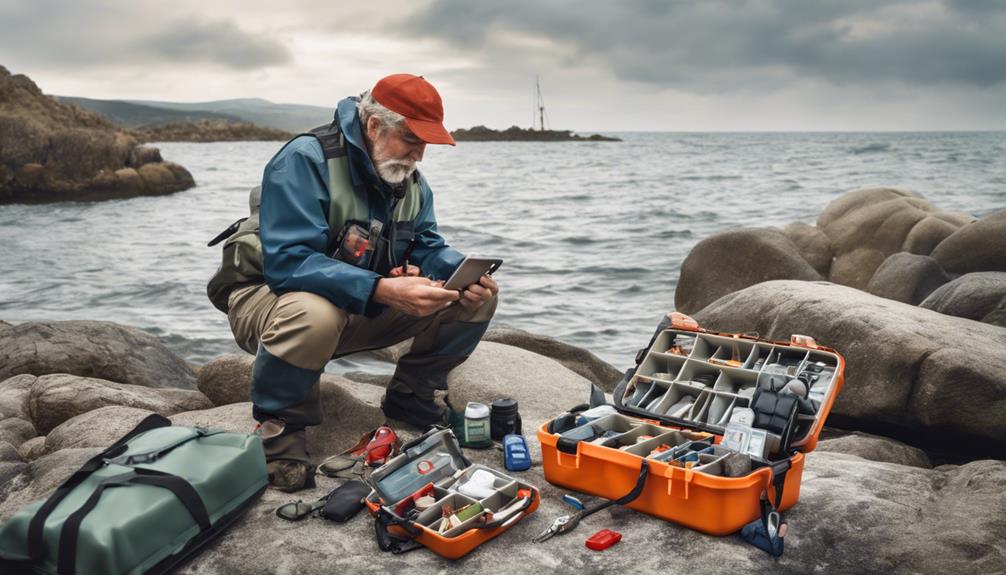
Mastering proper emergency preparedness is crucial for ensuring your safety while shore fishing. Being prepared for any unexpected situation is key to enjoying a worry-free fishing experience. One essential aspect of emergency preparedness is understanding emergency response procedures. Familiarize yourself with the location of the nearest emergency services and how to contact them quickly in case of an accident or injury while shore fishing. Additionally, consider investing in a personal locator beacon or a waterproof two-way radio for communication during emergencies.
Another vital component of emergency preparedness is having first aid training. Knowing basic first aid techniques can make a significant difference in providing immediate assistance to yourself or others in need. Consider taking a first aid course that includes CPR training, wound care, and how to handle common fishing-related injuries like hook punctures or cuts. Having a well-stocked first aid kit specifically tailored for shore fishing trips is also essential.
Educating Others on Fishing Safety
When sharing your fishing knowledge with others, emphasize the importance of safety practices to prevent accidents and injuries while enjoying the activity. Educating others on fishing safety is crucial for ensuring a pleasant and secure fishing experience. By following some essential safety tips and conducting a thorough risk assessment, you can help prevent mishaps and keep everyone safe.
- Always wear a properly fitting life jacket, even if you're a strong swimmer. Safety should never be compromised.
- Encourage the use of sunscreen to protect against harmful UV rays. Skin safety is just as important as other safety measures.
- Teach others about the potential risks of fishing near strong currents or slippery rocks. Awareness is key in avoiding dangerous situations.
- Emphasize the importance of staying hydrated and recognizing the signs of heat exhaustion. Health should never be overlooked during a fishing trip.
- Instruct on the proper handling of fishing equipment to prevent accidents like hooks getting caught in clothing or skin. Taking precautions can save from painful injuries.
Frequently Asked Questions
Can You Provide Tips for Staying Safe While Fishing Alone on Shore?
When you're fishing alone on shore, it's crucial to stay safe. Always be prepared for emergencies by carrying essential supplies and knowing basic first aid. Assess potential risks in your surroundings and plan accordingly.
Have a communication plan in place, informing someone of your location and expected return time. Consider learning self-defense techniques for added security. Prioritize your safety to ensure a successful and enjoyable fishing experience.
How Should I Handle Encounters With Wildlife While Shore Fishing?
When you encounter wildlife while shore fishing, stay calm and maintain a safe distance. Avoid sudden movements and loud noises.
Don't feed or approach the animals. Keep your fishing area clean to avoid attracting wildlife.
Always be aware of your surroundings and have a plan in case of encounters. Follow safety measures for wildlife encounters to ensure a safe fishing experience.
What Are Some Common Mistakes That Can Lead to Accidents While Shore Fishing?
When shore fishing, it is important to avoid common mistakes like not wearing proper footwear and failing to be aware of your surroundings. Proper footwear can prevent slips and falls, while being aware of the environment can help you avoid accidents. Additionally, it is crucial to maintain your equipment regularly and be prepared for emergencies. Remember, keeping your gear in good shape and knowing how to respond in emergencies are key for a safe fishing experience.
Proper footwear can prevent slips and falls, while being aware of the environment can help you avoid accidents. Remember, keeping your gear in good shape and knowing how to respond in emergencies are key for a safe fishing experience.
Are There Any Specific Safety Precautions to Take When Fishing in Rough Waters From Shore?
When fishing in rough waters from shore, it's crucial to prioritize safety. Be mindful of weather precautions to avoid risky situations.
Ensure your equipment is well-maintained for optimal performance. Have an emergency plan in place and carry communication devices for any unforeseen circumstances.
How Can I Ensure the Safety of Children or Pets Accompanying Me While Shore Fishing?
To ensure the safety of children or pets while shore fishing, supervision is key. Keep a close eye on them to prevent accidents. Minimize distractions by setting clear boundaries and rules.
When it comes to pet safety, make sure they're secured and can't run off. For child safety, consider using life jackets and teaching them basic water safety.
Conclusion
Remember, safety should always be your top priority when shore fishing. By following these best practices, you can enjoy a fun and successful fishing experience while staying safe.
Always be aware of local regulations, choose a safe fishing spot, and have the necessary safety gear on hand. Stay informed about weather conditions and be prepared for emergencies.
By taking these precautions and educating others on fishing safety, you can ensure a safe and enjoyable fishing trip every time.
